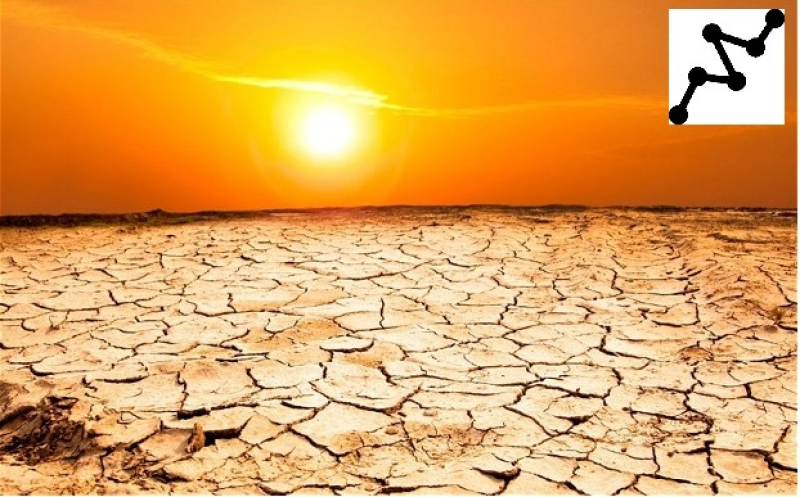Climat
Type of resources
Available actions
Keywords
Contact for the resource
Provided by
Years
Formats
Representation types
Update frequencies
status
Service types
-
Drought is a deficiency in precipitation over an extended period, usually a season or more, resulting in a water shortage that has adverse impacts on vegetation, animals and/or people. The Climate Moisture Index (CMI) was calculated as the difference between annual precipitation and potential evapotranspiration (PET) – the potential loss of water vapour from a landscape covered by vegetation. Positive CMI values indicate wet or moist conditions and show that precipitation is sufficient to sustain a closed-canopy forest. Negative CMI values indicate dry conditions that, at best, can support discontinuous parkland-type forests. The CMI is well suited to evaluating moisture conditions in dry regions such as the Prairie Provinces and has been used for other ecological studies. Mean annual potential evapotranspiration (PET) was estimated for 30-year periods using the modified Penman-Monteith formulation of Hogg (1997), based on monthly 10-km gridded temperature data. Data shown on maps are 30-year averages. Historical values of CMI (1981-2010) were created by averaging annual CMI calculated from interpolated monthly temperature and precipitation data produced from climate station records. Future values of CMI were projected from downscaled monthly values of temperature and precipitation simulated using the Canadian Earth System Model version 2 (CanESM2) for two different Representative Concentration Pathways (RCP). RCPs are different greenhouse gas concentration trajectories adopted by the Intergovernmental Panel on Climate Change (IPCC) for its fifth Assessment Report. RCP 2.6 (referred to as rapid emissions reductions) assumes that greenhouse gas concentrations peak between 2010-2020, with emissions declining thereafter. In the RCP 8.5 scenario (referred to as continued emissions increases) greenhouse gas concentrations continue to rise throughout the 21st century. Multiple layers are provided. First, the mean annual Climate Moisture Index is shown across Canada for a reference period (1981-2010). Projected mean annual Climate Moisture Index is available for the short- (2011-2040), medium- (2041-2070), and long-term (2071-2100) under the RCP 8.5 (continued emissions increases) and, for the long-term (2071-2100), under RCP 2.6 (rapid emissions reductions). Reference: Hogg, E.H. 1997. Temporal scaling of moisture and the forest-grassland boundary in western Canada. Agricultural and Forest Meteorology 84,115–122.
-

This series of datasets has been created by AAFC’s National Agroclimate Information Service (NAIS) of the Agro-Climate, Geomatics and Earth Observations (ACGEO) Division of the Science and Technology Branch. The Canadian Drought Monitor (CDM) is a composite product developed from a wide assortment of information such as the Normalized Difference Vegetation Index (NDVI), streamflow values, Palmer Drought Index, and drought indicators used by the agriculture, forest and water management sectors. Drought prone regions are analyzed based on precipitation, temperature, drought model index maps, and climate data and are interpreted by federal, provincial and academic scientists. Once a consensus is reached, a monthly map showing drought designations for Canada is digitized. AAFC’s National Agroclimate Information Service (NAIS) updates this dataset on a monthly basis, usually by the 10th of every month to correspond to the end of the previous month, and subsequent Canadian input into the larger North American Drought Monitor (NA-DM). The drought areas are classified as follows: D0 (Abnormally Dry) – represents an event that occurs once every 3-5 years; D1 (Moderate Drought) – represents an event that occurs every 5-10 years; D2 (Severe Drought) – represents an event that occurs every 10-20 years; D3 (Extreme Drought) – represents an event that occurs every 20-25 years; and D4 (Exceptional Drought) – represents an event that occurs every 50 years. Impact lines highlight areas that have been physically impacted by drought. Impact labels specify the longitude and magnitude of impacts. The impact labels are classified as follows: S – Short-Term, typically less than 6 months (e.g. agriculture, grasslands). L – Long-Term, typically more than 6 months (e.g. hydrology, ecology).
-

The Drought Impact Label dataset is used on all drought polygons from D1 to D4 to specify the longitude and magnitude of impacts. Impact labels are often used in association with the Drought Impact Line dataset. The impact labels are classified as follows: S – Short-Term, typically less than 6 months. L – Long-Term, typically more than 6 months. SL – A combination of Short and Long-Term impacts.
-

The Drought Impact Lines dataset highlights areas that have been physically impacted by drought. All drought impact lines have a drought impact label inside of them to express the longevity of the impact. The impact lines are classified using impact labels as follows: S – Short-Term, typically less than 6 months. L – Long-Term, typically more than 6 months. SL – A combination of Short and Long-Term impacts.
-

The datasets contain land surface evapotranspiration (ET, in mm of H2O) for Canada's landmass at a spatial resolution of 5-km and temporal intervals of a month and a year over a 24-year period of 2000-2023. The ET was produced by the Land Surface Model EALCO (Ecological Assimilation of Land and Climate Observations) developed at Natural Resources Canada. The EALCO model was run at a 30-minute time step. The monthly (or annual) ET in the datasets is the sum of the 30-minute ET values in a month (or a year). Dew and frost formations simulated by EALCO are included in the ET as negative values, so the ET represents the net water flux between land surface and the atmosphere. Details of the datasets and the EALCO ET modelling algorithms can be found in Wang (2007, Simulation of Evapotranspiration and Its Response to Plant Water and CO2 Transfer Dynamics. J. Hydrometeorology, 9, 426-443, doi: 10.1175/2007JHM918.1) and Wang et al. (2013, Spatial and seasonal variations in evapotranspiration over Canada’s landmass. Hydrol. Earth Syst. Sci., 17, 3561–3575, doi:10.5194/hess-17-3561-2013).
-

This map shows the projected average change in mean temperature (°C) for 2046-2065, with respect to the reference period of 1986-2005 for RCP4.5. The median projected change across the ensemble of CMIP5 climate models is shown. For more maps on projected change, please visit the Canadian Climate Data and Scenarios (CCDS) site: https://climate-scenarios.canada.ca/?page=download-cmip5.
-

This map shows the projected change in mean precipitation for 2016-2035, with respect to the reference period of 1986-2005 for RCP4.5, expressed as a percentage (%) of mean precipitation in the reference period. The median projected change across the ensemble of CMIP5 climate models is shown. For more maps on projected change, please visit the Canadian Climate Data and Scenarios (CCDS) site: https://climate-scenarios.canada.ca/?page=download-cmip5.
-

This map shows the projected average change in mean temperature (°C) for 2081-2100, with respect to the reference period of 1986-2005 for RCP4.5. The median projected change across the ensemble of CMIP5 climate models is shown. For more maps on projected change, please visit the Canadian Climate Data and Scenarios (CCDS) site: https://climate-scenarios.canada.ca/?page=download-cmip5.
-

This map shows the projected change in mean precipitation for 2046-2065, with respect to the reference period of 1986-2005 for RCP8.5, expressed as a percentage (%) of mean precipitation in the reference period. The median projected change across the ensemble of CMIP5 climate models is shown. For more maps on projected change, please visit the Canadian Climate Data and Scenarios (CCDS) site: https://climate-scenarios.canada.ca/?page=download-cmip5.
-

This map shows the projected change in mean precipitation for 2016-2035, with respect to the reference period of 1986-2005 for RCP8.5, expressed as a percentage (%) of mean precipitation in the reference period. The median projected change across the ensemble of CMIP5 climate models is shown. For more maps on projected change, please visit the Canadian Climate Data and Scenarios (CCDS) site: https://climate-scenarios.canada.ca/?page=download-cmip5.
 Arctic SDI catalogue
Arctic SDI catalogue